

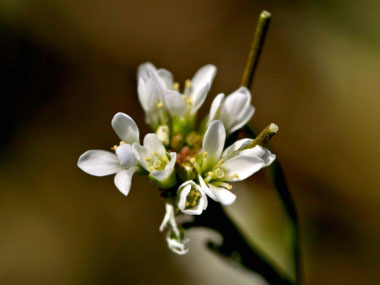
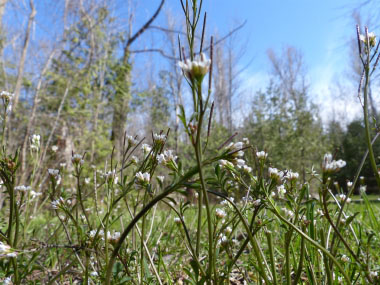
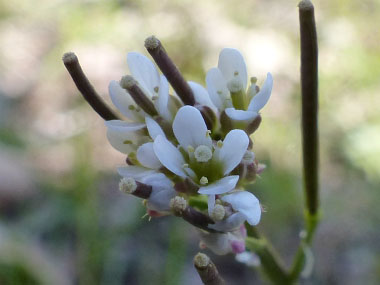
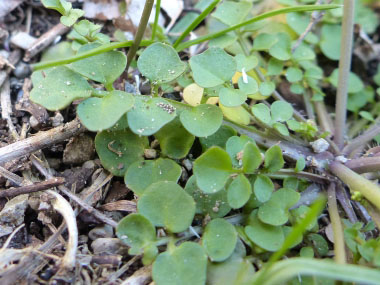
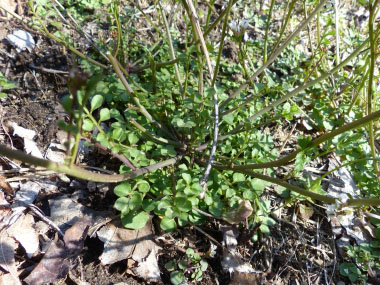

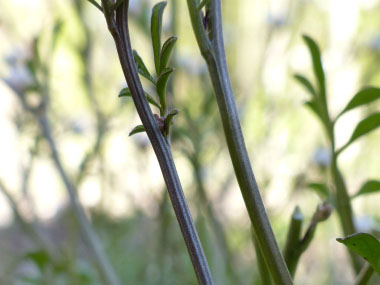
To support our efforts please browse our store (books with health benefits, etc.).
Hairy bittercress is a common plant yet not one that makes it on the top twenty list of favourites. Like other members of the mustard family (Brassicaceae), it is a winter annual or biennial plant that is native to Europe and Asia, but has naturalized worldwide. It is sometimes referred to a flickweed because the pods flick the seeds out when ripe.This plant has a twelve week lifecycle so if left undisturbed a patch can grow quite substantially in a year. Cardamine is Dioscorides' name for cress.
Distinguishing Features
Hairy bittercress can appear like other cresses but it can be differentiated by its dense rosette and that it often has many stems.The stems are usually erect and in the typical mustard manner, seed pods grow along the upper stem, above the leaves and below the flower.
Flowers
Flowers are tiny (2.5 to 5 mm long), white, with four petals. They grow in small groups at the top of a vertical stem. The stigma is sessile or almost sessile. Sepals measure 1.5 to 3 mm long. They are usually green with a white margin. Typically there are four stamens, sometimes six. Flowers bloom late April to early June depending on geographical location.
 Fields
of Nutrition has medicinal benefits and vitamin/mineral content of Hairy Bittercress.
Fields
of Nutrition has medicinal benefits and vitamin/mineral content of Hairy Bittercress.
Leaves
Leaves are basal rosette, many-leaved, stem leaves are alternate, usually 2 to 4, rosette leaves are smaller, stalked, with the stalk somewhat hairy. The blade is pinnate, 1 to 4 paired, with terminal leaflet, leaflets are roundish, terminal leaflet larger than others. Leaves are kidney-shaped.
Height
This species grows to no more than 30 centimetres (12") tall. The stem is erect and usually glabrous.
Habitat
Hairy bittercress occurs on bare soil, in woodlands, and sometimes in light grassy areas. It likes dry slopes, juniper meadows, forest margins, wasteland, crags, rocky outcrops, sometimes as a gardens weed. This plant grows on all continents with the exception of Antarctica.
Edible Parts
This plant is great for salads, salsa, pestos and anywhere you would use raw cress. It loses most of its almost argula-like flavour when cooked. Flowers and leaves are edible. Flowers can be tough to chew. Leaves are tender and have lots of vitamin C, calcium, magnesium, beta-carotene, as well as antioxidants.
Other Name
Hoary Bittercress.
Similar Plants
Hoary Cress (Lepidium draba).
Winter Survival Food Handbook

PDF Plant Magazines
Types of Wild Food
Geographic Zones Seasons
Disclaimer
EdibleWildFood.com is informational in nature. While we strive to be 100% accurate, it is solely up to the reader to ensure proper plant identification. Some wild plants are poisonous or can have serious adverse health effects.
We are not health professionals, medical doctors, nor are we nutritionists. It is up to the reader to verify nutritional information and health benefits with qualified professionals for all edible plants listed in this web site. Please click here for more information.
Why Edible Wild Food?
- Food costs are rising
- Free, wild food is readily abundant
- Wild food adds nutrition to your diet
- Wild food can help treat various medical conditions





